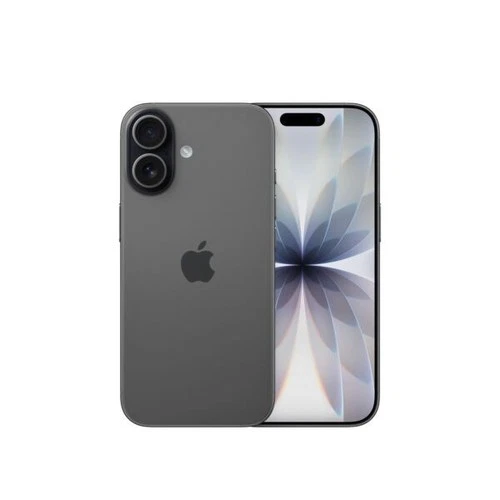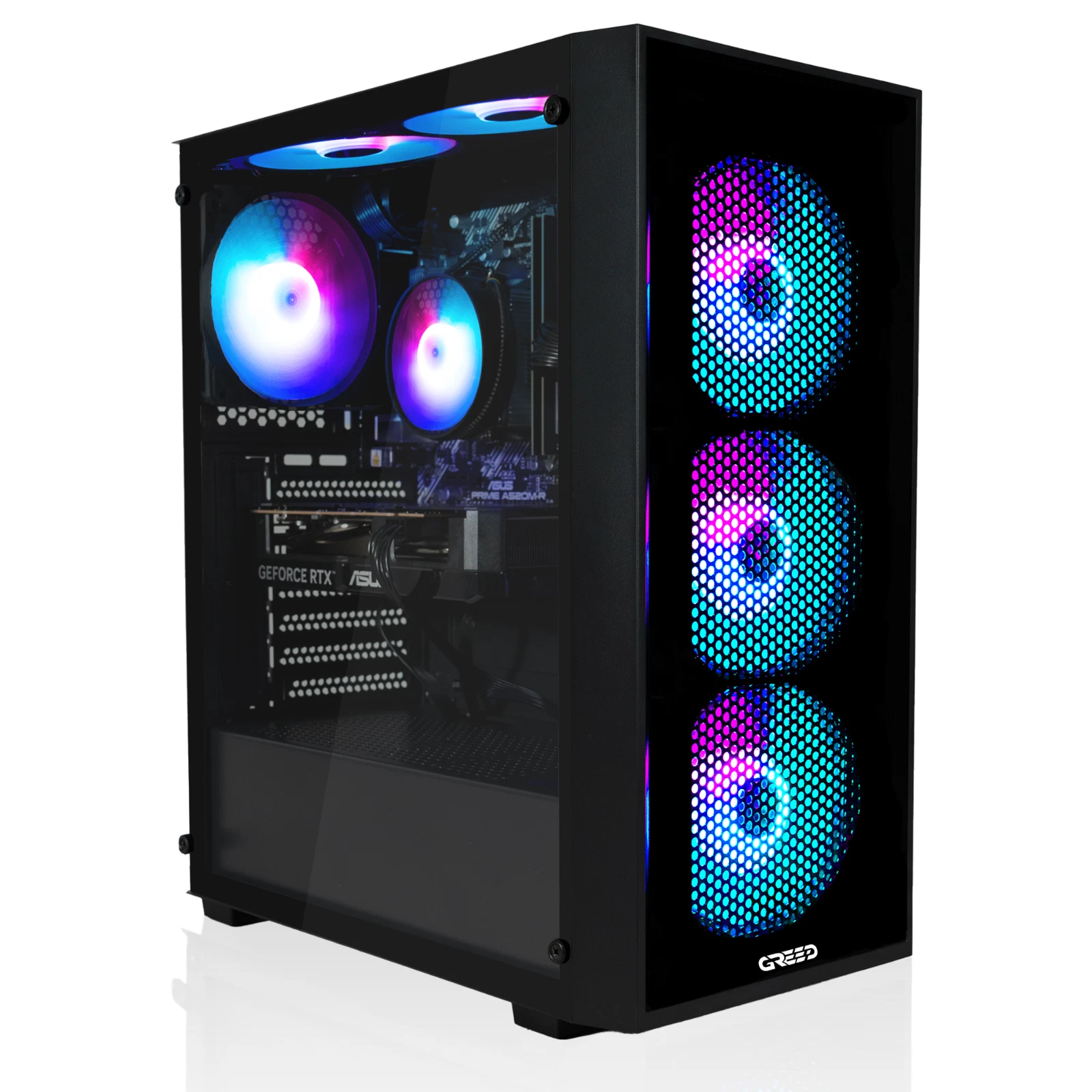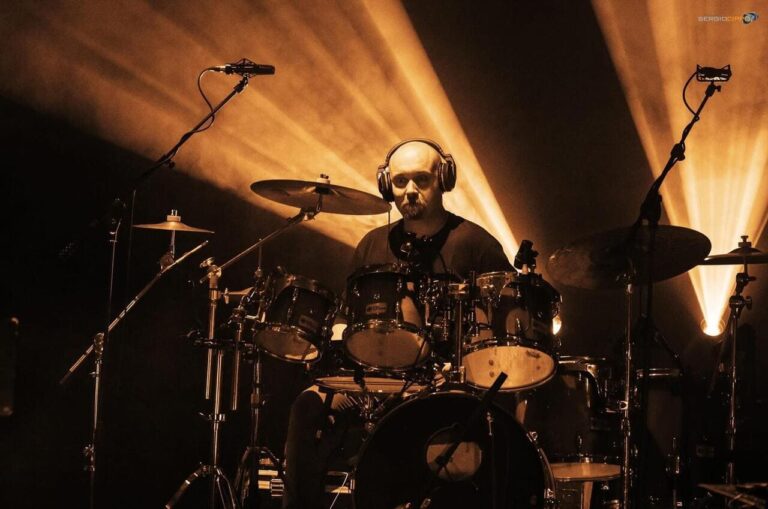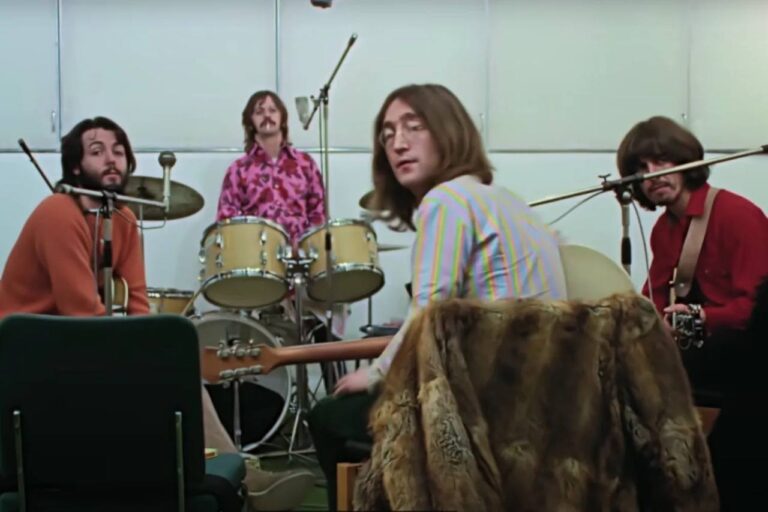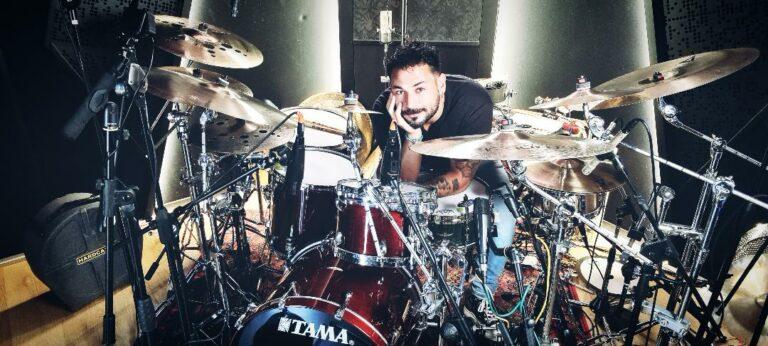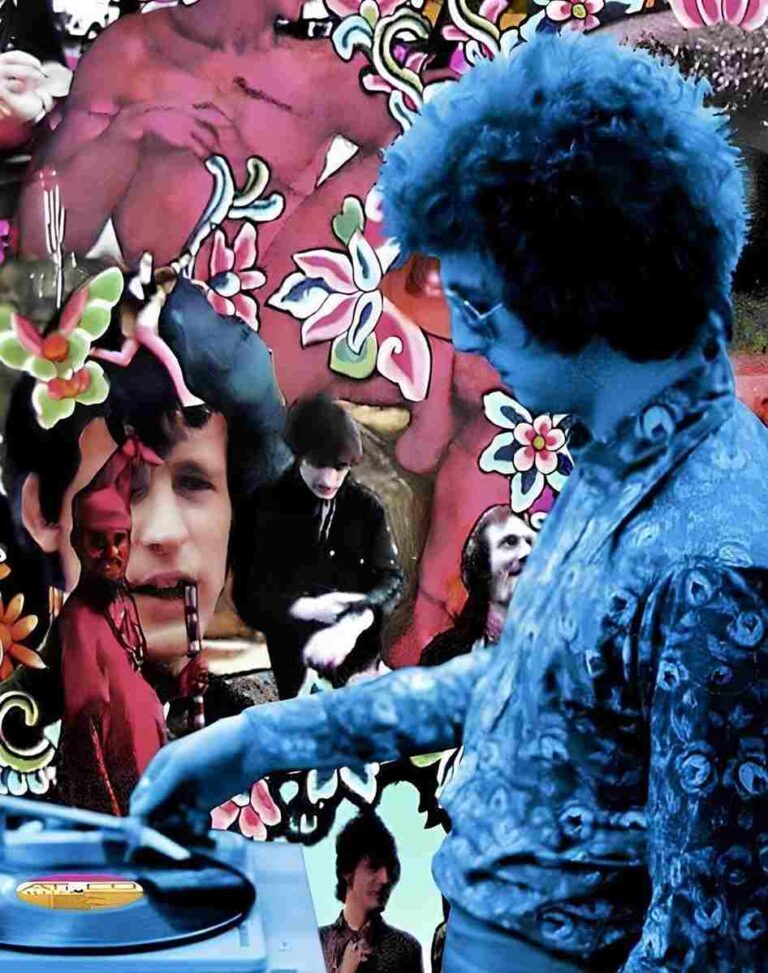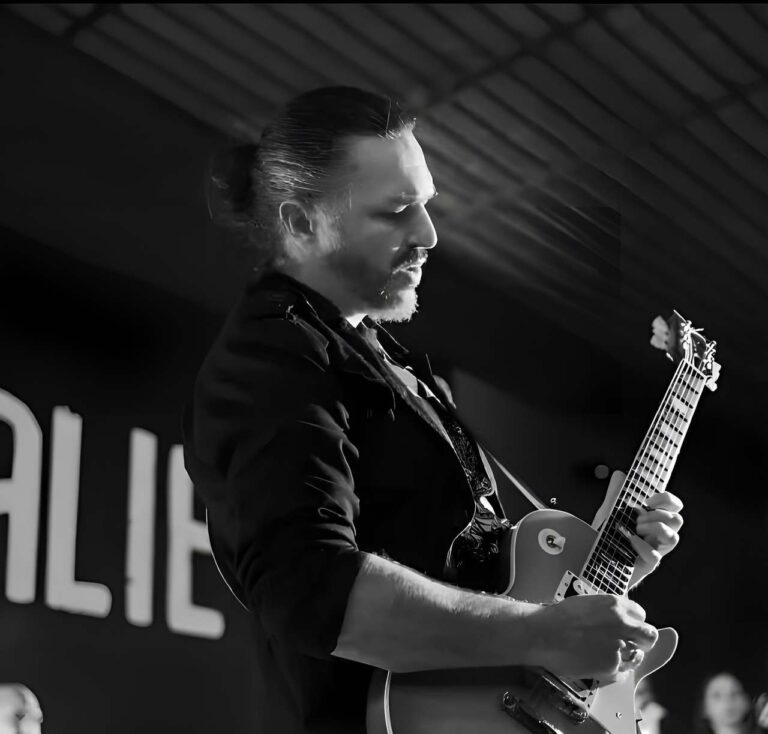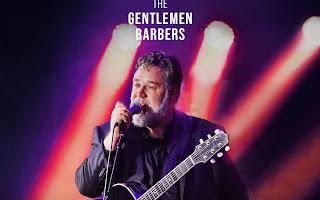Garry “Moonboot” Masters: i ricordi del fondatore di The Magic Mushroom Band della scena musicale londinese anni ’60 e ’70
Garry “Moonboot” Masters è nato e cresciuto a Londra e attualmente risiede in Australia, co-fondatore di The Magic Mushroom Band e dei side project del gruppo Astralasia e Moonboot Oz. E’ noto anche per le sue release solo Electrified Moonboot e Bone Idol, capolavoro hard rock ispirato ai power trio degli anni ’60. Il musicista britannico ha condiviso con noi le sue tante memorie, osservazioni, opinioni, intuizioni della scena musicale londinese degli anni ’60 e ’70.
Intervista a Garry “Moonboot” Masters
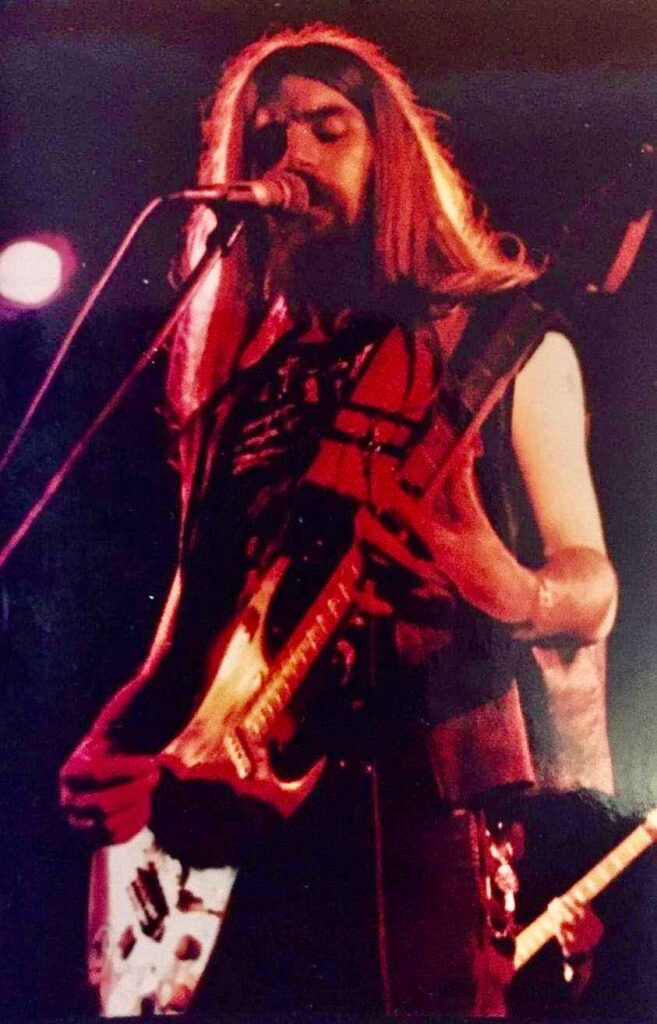
Come è stato crescere a Londra, il centro dell’universo musicale nella metà e alla fine degli anni ’60 fino ai ’70? Essendo nato nel 1060 eri molto giovane ai tempi dei The Beatles, Stones, Kinks e degli altri gruppi che dominavano il mondo musicale. Potresti condividere con noi alcuni ricordi che hai del Movimento Hippie della fine degli anni ’60. Tipo la rottura dei Beatles, Jimi Hendrix, Arthur Brown e qualsiasi altro evento significativo del mondo rock britannico?
Come hai detto tu, io sono nato nel 1960, non ero abbastanza grande per apprezzare in pieno l’impatto dell’esplosione psichedelica della swinging London. Qualche volta in passato ho rimpianto questo, ma naturalmente andando avanti con gli anni, ora ne sono abbastanza felice! Fortunatamente vengo da una famiglia musicale così c’era sempre musica intorno a me. Sono cresciuto in una cittadina chiamata Acton ad Ovest di Londra. Un’oasi di attività musicale in se stessa. The Who provengono da li, infatti mio zio faceva delle jam con loro nei primissimi tempi. Mia zia, invece, frequentava un ragazzo che si chiamava Terry Nellams e che poi cambiò il suo nome in Adam Faith.
Un’altra grande band di Acton erano gli Stray che facevano hard rock. Io potevo vedere il famoso “Post Office Tower” di Central London dalla finestra della mia camera da letto. Ecco quanto vicino all’azione mi trovavo. Più avanti, con un gruppo di amici altrettanto “entusiasti”, ci recavamo a piedi in centro Londra. Se passava un bus lo prendevamo ma più frequentemente non accadeva e quindi andavamo a piedi. Più spesso la sera quando era tardissimo.
Garry Moonboot Masters
Un’eredità musicale
Come ho già detto, la mia famiglia era musicale. Io conservo tanti bei ricordi delle feste in famiglia dove ognuno imbracciava uno strumento. Quelli che non sapevano suonare cantavano.
Mio padre era un fantastico pianista. Lui amava il jazz, il boogie-woogie e il blues e suonava regolarmente nei vari club, sia da solo che con una band. Mio zio Eddie è un bassista, suona dagli anni ’60 e ancora fa delle gigs con delle band di blues. Anche mia nonna era una pianista e spesso suonava ai pubs locali. Così davvero la musica è qualcosa che abbiamo nel sangue io e quelli della mia famiglia. Purtroppo non sono mai riusciti a pubblicare un album e, come si usava ai tempi, la maggior parte degli spettacoli erano con pezzi a richiesta degli standards di quei tempi. Sono molto orgoglioso di essere stato l; unico Master con un’eredità nel songwriting. Uno che ha realizzato numerosi album ed ha suonato le sue canzoni davanti ad ampie audience.
Garry Moonboot Masters
Le prime collezioni di dischi
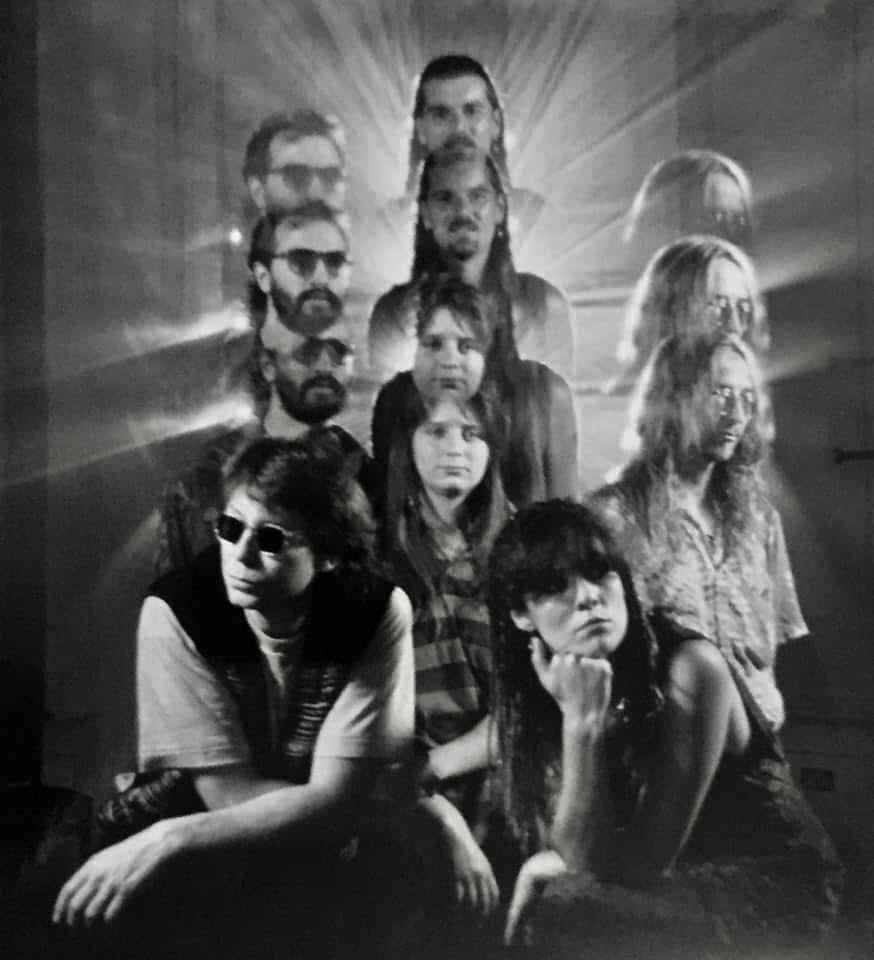
Le mie prime collezioni di dischi sono state ovviamente dei Beatles e dei Rolling Stones. Loro stavano dappertutto, in radio, in tv, sui giornali naturalmente. E probabilmente le varie band collegate ad un certo tipo di “armamentario”. Dagli stivali dei Beatles alle parrucche alle cartoline, bubble gum e posters. Io ero il più grande della mia famiglia cosi tanti miei amici avevano fratelli e sorelle più grandi ed io ascoltavo la loro collezione di dischi. Anche i miei zii e le mie zie condividevano i loro dischi con me…
Per quanto riguarda gli anni psichedelici, li notai maggiormente (ed ero un ragazzino) quando divennero più commerciali. Un ricordo molto chiaro che ho viene da una vacanza in famiglia. Spesso stavamo nei caravan o in campeggio vicino alla costa e c’era sempre qualche discoteca da quelle parti. Una volta in particolare, avrò avuto circa otto anni, ci stavamo avviando verso questo locale ed io potevo sentire questa fantastica musica messa dal DJ.
Appena entrai fui colpito dall’alto volume della musica e da un gioco di luci psichedeliche con un intenso profumo di incenso. C’erano gruppi di ragazze hippie vestite con abiti colorati che ballavano qui e li e a quel punto non so cosa mi sia preso. Decisi che avrei dovuto unirmi a loro! I miei genitori pensarono che fossi ridicolo ma io mi sentivo particolarmente a mio agio in quell’ambiente…Sicuramente un segno delle cose che sarebbero venute.
Da quel momento in poi la musica significò per me molto di più che qualcosa da ascoltare alla radio.…
Garry Moonboot Masters
La prima chitarra di Garry “Moonboot” Masters
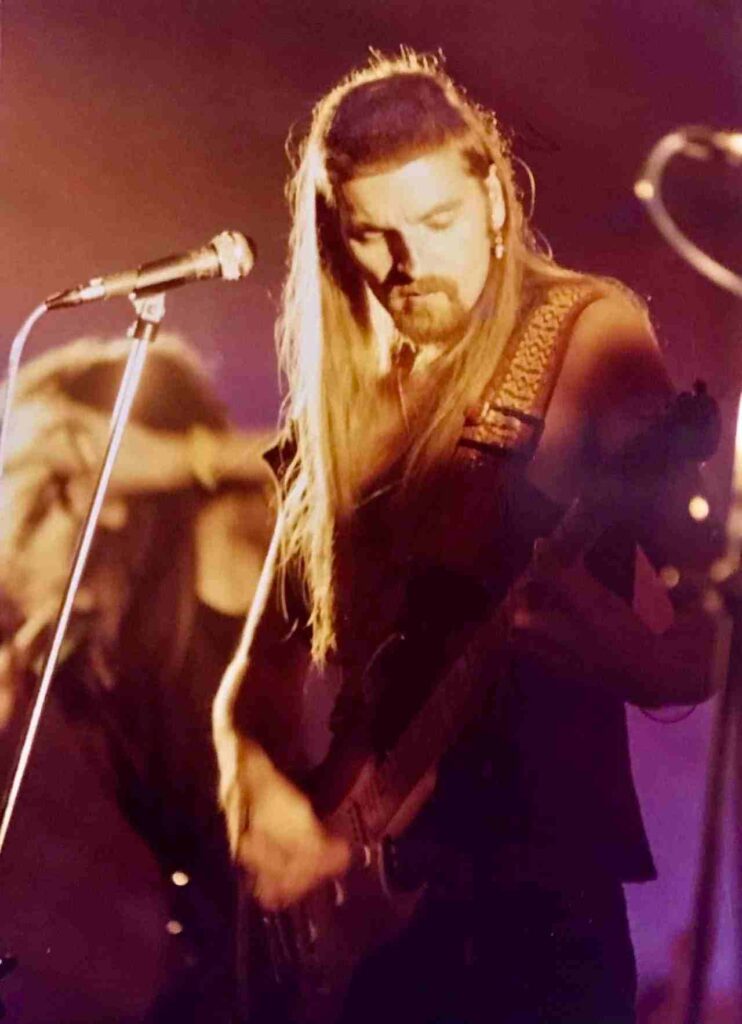
Ho avuto la mia prima vera chitarra, un’acustica, all’incirca a dodici anni. Prima di ciò mio padre mi aveva insegnato le basi per suonare la chitarra ukulele, la qualcosa era molto più facile con le mie piccole mani. Ero ansioso di imparare. Il primo 45 giri che acquistai fu Brand New Key di Melanie e da quel momento in poi non mi sono più fermato. Ero grato a mio padre per avermi insegnato i rudimeni dello strumento ma ero pronto per progredire e stavo già scrivendo canzoni usando le mie limitate conoscenze.
Ebbi la mia prima, basica Stratocaster comprandola tramite un annuncio di un quotidiano e mi arrivò con un piccolo amp per fare pratica. Lo suonavo dal momento in cui tornavo a casa dalla scuola fino a quando andavo al letto. Questo ovviamente scocciava le mie povere sorelle che soffrivano con quel rumore stando nella stanza accanto alla mia. Erano i primi anni ’70 e la mia passione per la musica e per la chitarra prese il sopravvento. A quell’epoca avevo scoperto Hendrix, Cream, Led Zeppelin e la mia chitarra acustica stette ferma per un bel po’ in un angolino fino ad impolverarsi.
I concerti rock a Londra da teenager
All’età di circa tredici/quattordici anni, cominciai ad andare ai concerti con i miei amici. Avevamo l’imbarazzo della scelta, potendo andare fuori ogni sera della settimana e vedere una favolosa band suonare ogni volta. Una volta cresciuti cominciammo a viaggiare e ad andare anche più lontano per vedere un concerto che ci piaceva. I miei locali preferiti a Londra erano The Marquee e The Roundhouse. Poi c’erano degli eventi occasionali in posti tipo Hyde Park. Per quanto riguarda vedere i gruppi più famosi, la cittadina più vicina ad Acton era Hammersmith, casa del celebre Hammersmith Odeon. Andavamo li almeno una volta al mese quando suonavano le band top del momento.
I negozi trend negli anni ’60 e ’70 a Londra
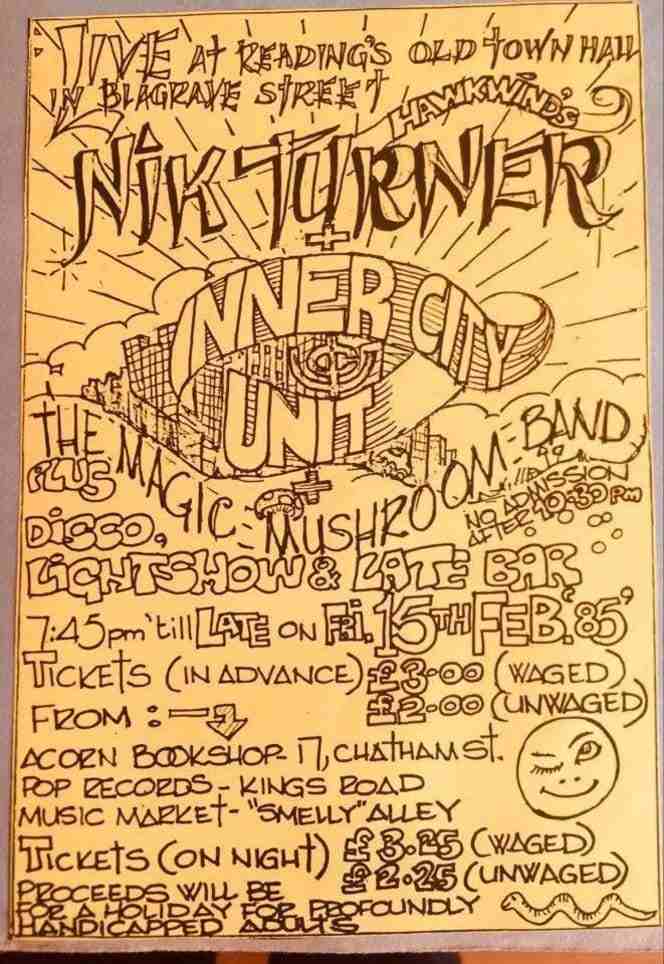
Tutto questo coincise con la mia conoscenza del Portobello Road Market a Notting Hill, anche questo una bella passeggiata lunga a piedi da casa. Questo posto aveva per me la stessa importanza che aveva la musica che ascoltavo. Probabilmente la cosa più vicina che noi inglesi avevamo all’Haight/Ashbury di San Francisco.
Quel posto era un incrocio di culture mescolate ed io ebbi la possibilità di conoscerlo negli ultimi anni in cui il genere hippie era ancora così di moda. Poi scoprii gli Head Shops e tutto l’inventario collegato ad essi (giornali underground, comix/pipes/bongs/beads). C’erano anche dei grandiosi negozi di dischi e mercatini che mi introdussero all’immensa scena “underground” e dove conobbi band come The Pink Fairies/Deviants, Edgar Broughton Band, Daevid Allen e la Gong Family.
Le fondamenta della musica di Garry
Avevo già scoperto gli Hawkwind quando conquistarono le classifiche con il loro singolo Silver Machine vedendoli in tv. Anche quello fu un momento storico per me. Quelle sono state le vere fondamenta della mia musica, cosi come i musicisti più celebri ebbero un’influenza su di me. La scena underground all’epoca era fantastica e mi mostrò come potessi portare la musica insieme a me dovunque trovando persone che la apprezzavano. Come gli anni ’70 procedevano, io passavo un sacco di tempo non soltanto immergendomi in quello che stava accadendo in quel periodo ma anche cercando di tenermi informato circa quello che avevo perso durante i primi anni ’60…
The Magic Mushroom Band, Hawkwind e Motörhead
Quando The Magic Mushroom Band apparvero allo Stonehenge Festival nel 1983 e nel 1984, gli Hawkwind erano li nella stessa serata? Se non fu così, la tua band apparve mai nella stessa locandina per la stessa serata con gli Hawkwind? Che opinione hai di questa band, ti hao influenzato musicalmente?
The Magic Mushroom Band suonarono allo Stonehenge festival sia nel 1983 che nel 1984 e per quanto mi ricordi, gli Hawkwind fecero lo stesso. Noi non suonammo mai sul “main stage” perché eravamo troppo occupati a suonare su tutti gli altri palcoscenici intorno, ovunque fosse possibile. Sebbene seppi poi che ad un certo punto ci avevano chiamato per il main stage ma in quel momento stavamo suonando da qualche altra parte…
Si’, abbiamo suonato molte volte con gli Hawkwind nel corso degli anni, sia negli “all-dayers” con altre band che come support act per loro. Come ho detto prima, loro sono stati per me una grande influenza ed anche per gli altri membri della mia band. Li ho seguiti da quando hanno avuto la loro prima hit Silver Machine quindi è stato un grande onore alla fine poter dividere il palcoscenico con loro.
Il rock “anarchico” di Lemmy dei Motörhead
Per quanto riguarda Lemmy, frequentavo gli stessi posti che frequentava lui, specialmente a Portobello Road e ci salutavamo giusto con un cenno della testa. Però una volta lui venne a vedere un concerto dei Magic Mushroom Band e ci facemmo una bella chiacchierata al bar. Penso che i Motörhead fossero grandiosi, come un respiro di aria fresca. Ho sempre pensato che Lemmy avesse fatto un affarone a venir cacciato fuori dagli Hawkwind (per motivi di droga!) Ma poi ritornò sulle scene più forte che mai. Il potere e l’energia dei suoi primi live show strano incredibili.
I Motörhead spuntarono fuori come punk band e ad essere onesti in quel periodo la scena rock era un po’ stagnante. Era fatta per lo più di infiniti e pomposi assolo che contenevano poca sostanza. Il punk non fu facile da accettare i primi tempi ed era molto anti rispetto a quello che si era fatto fino a quel momento. Ma i Motörhead produssero la stessa energia anarchica che può essere rintracciata nei giorni dei MC5, degli Stooges… Amavo i Ramones, per le stesse ragioni…
Il glam rock di David Bowie e dei T.Rex di Marc Bolan
Garry, qual’è la tua opinione sul Glam Rock? E per espandere la domanda, cosa ne pensi di David Bowie e del suo personaggio Ziggy Stardust? Quale fu la tua reazione all’album Ziggy Stardust? Secondo te Ziggy ha avuto una qualche influenza sulla moda inglese, l’hairstyle…? Ad un certo punto il glam rock aveva conquistato il mondo con Bowie e Marc Bolan e con I fans di entrambi che discutevano su chi fosse il migliore.
Quando ero un teenager pensavo che il glam fosse grandioso! Amavo i T.Rex, quel magnifico no-nonsense boogie. Amavo le lyrics di Marc (n.d.r. Bolan) e le semplici melodie che si accoppiavano perfettamente. Mi piaceva molto anche imparare a suonare con la chitarra il loro materiale. Sapendo della mia passione per i T.Rex, mio zio mi diede due dei primi album dei Tyrannosaurus Rex e devo dire che piacquero molto all’hippie che c’era in me. Oltre ai T.Rex, c’erano Bowie, Alice Cooper, Mott the Hoople e molti altri. Una musica grandiosa, di qualità, che quel periodo era tutta nelle classifiche. E’ difficile crederci oggigiorno…
David Bowie e il suo personaggio Ziggy Stardust
Quando Bowie presentò il personaggio di Ziggy Stardust, era come se davvero lui fosse diventato un alieno che cambiava forma. Non come tutti gli altri glam rockers che andavano tanto di moda all’epoca. Ma lui era come se fosse di un altro pianeta. Mike Ronson giocò una parte fondamentale nello sviluppo del suono degli Spiders From Mars ma erano le canzoni e le lyrics di Bowie ad essere diverse da quelle di chiunque altro. E’ dura dire se preferissi Bolan o Bowie perché, anche se facevano parte della medesima scena, loro erano due individualità uniche. Ma direi che Bowie ha portato la musica in avanti facendola progredire, reinventando continuamente se stesso. Bolan, invece, perse la vita tragicamente nel 1977 ma la sua musica, già a quell’epoca, aveva perso un po’ del suo smalto.
Garry parla di Alice Cooper e dei suoi inizi
C’è un altro nome che mi piacerebbe menzionare, Alice Cooper. Lui era conosciuto in Inghilterra? A me piaceva molto il suo materiale degli inizi, tipo Ballad of Dwight Fry. Ma anche la sua tecnica artistica nelle performances, che includevano ghigliottine, camice di forza…Per non parlare del suo famoso serpente boa constrictor…
Alice Cooper è diventato famosissimo con la release del singolo School’s Out. Fu una mossa strategica molto furba con un tema che garantiva il fatto che qualsiasi ragazzino l’avrebbe apprezzato. Ed anche se faceva parte dello stesso filone del glam rock, lui inventò lo Shock Rock nel mondo, qualcosa che in precedenza era stato fatto soltanto da acts come gli Streaming Lord Sutch e ovviamente, Arthur Brown.
I singoli che Alice Cooper realizzò dopo School’s Out erano comunque grandiosi e così lo erano i suoi primi album. Questo fino a che non andò fuori dai binari alla fine degli anni ‘70 e quando cominciò a fare dell’heavy metal un po’ più standardizzato negli anni ’80. Comunque proprio in quel periodo lo andai a vedere esibirsi dal vivo. Fece molte delle sue vecchie hits in modo molto teatrale ed anche il nuovo materiale era molto meglio ascoltato dal vivo.
Garry “Moonboot” Masters e la storia di Magic Mushroom Band
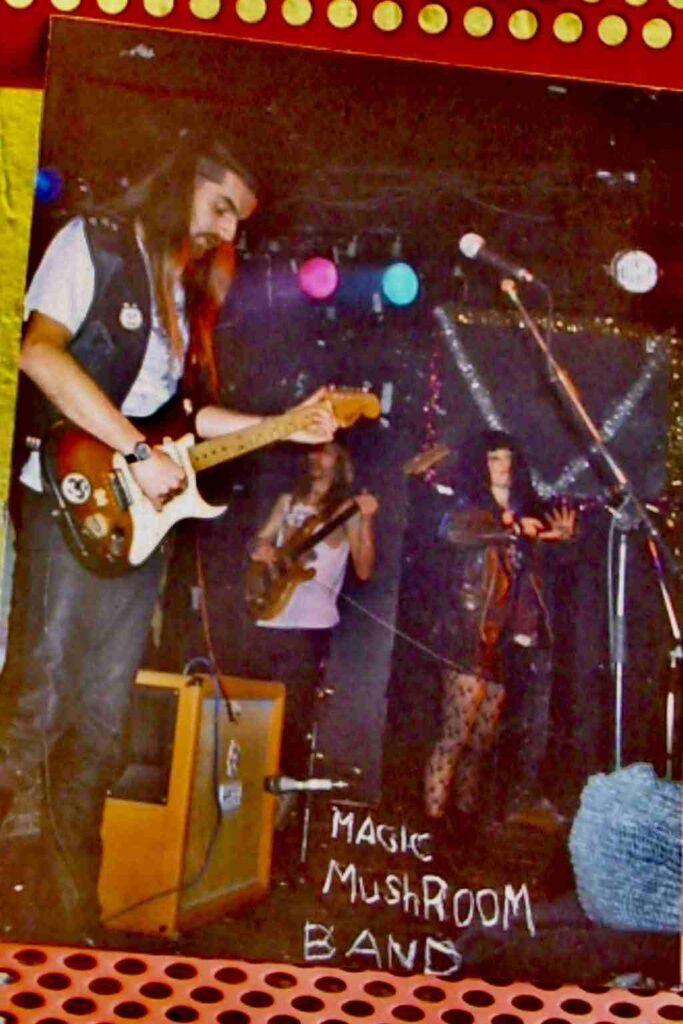
Garry, parliamo dei Magic Mushroom Band, il gruppo di cui sei co-fondatore nato nel 1982 e del suo side project Astralasia. Potresti cortesemente dare a me e a tutti i lettori di BACKdigit.com una breve panoramica sulle aggrovigliate dinamiche riguardanti queste due formazioni?
Con The Magic Mushroom Band tutto stava nel divertirsi, qualcosa che avevamo ereditato dalle nostre precedenti band… Nel 1982, quando la band si formò, la New Wave e il New Romantics erano emersi dal chaos creato dal punk e il loro aspetto in generale era spesso dark e misterioso. Molti dei brani erano upbeat con un messaggio positivo che attraversava le registrazioni e maggiormente anche i concerti live.
Questo specialmente quando mettevano su dei concerti influenzati dalla psichedelia, come eravamo soliti fare fin dal principio. Se fossi venuto ad uno dei nostri concerti di quell’epoca potevi stare certo che ti saresti divertito. Non a caso tanta gente ancora mi contatta e mi dice di avere ancora dei bellissimi ricordi dei nostri concerti live e della gioia che gli hanno dato. In alcuni casi i nostri concerti hanno aiutato anche a far nascere delle amicizie e delle relazioni sentimentali. La gente veniva per ballare e per condividere amore, illuminata dalle luci psichedeliche. Avevamo un nostro amico DJ che si chiamava Kevin e che nel 1988 ci parlò di qualcosa di nuovo apparso sulle scene.
Si chiamava Acid House ed era uno spettacolo dove i ragazzi si incontravano per ballare, condividere affetto, anche in questo caso nell’atmosfera delle luci psichedeliche. Ovviamente la musica era molto differente, il 4/4 tipico del rock veniva sostituito dai beat tipici della dance.
Un nuovo line-up per The Magic Mushroom Band
Nel 1990 The Magic Mushroom debuttarono con un line-up rinnovato. Il chitarrista originario Craig Twining aveva abbandonato il gruppo per dedicarsi a nuove avventure. Lo stesso aveva fatto il batterista originario James Lacey. Furono rimpiazzati da Ed “Bones” Genis alla chitarra slide/rhythm, Sam Turner al violino elettrico. Kim Oz entrò nel gruppo in qualità di tastierista e di cantante mentre il nostro nuovo batterista era Swordfish. Lui era stato produttore/ingegnere del suono per il nostro secondo e terzo album Bomshamkar e Eyes of the Angel.
Immediatamente ci siamo ritrovati al lavoro sul nostro prossimo album che era Process of Illumination. All’epoca la scena Acid House era cresciuta e nuovi stili si erano formati come il World/Ambient, la Techno/Trance e Swordfish era tremendamente felice di sperimentare quello stile mentre lavoravamo al nostro nuovo album. Registrammo un EP su cassetta di suoni sperimentali in quello stile tanto per testare la situazione e usammo il nome Astralasia per differenziarlo da The Magic Mushroom Band.
Sebbene il nostro materiale iniziale fosse suonato dagli stessi membri e tutti sulla scena sapessero che le due band erano in realtà la stessa band. Questo ci aiutò a lanciare gli Astralasia e nel contempo a far conoscere meglio anche The Magic Mushroom Band. Con il passare del tempo cominciammo anche a tenere dei live show con entrambe le band facendo a turno su chi dovesse essere il primo nome e chi il nome di supporto.
Il successo di The Magic Mushroom Band e di Astralasia
Nel 1992 entrambe le band erano sotto contratto con la Magick Eye Records che realizzò una serie di album e di dischi 12 pollici per ciascuna delle band. E’ stata la miglior casa discografica che abbiamo mai avuto e una buona distribuzione unita ad una forte pubblicità aiutò entrambe le band a sfondare. Il primo album per Magick Eye Records di The Magic Mushroom Band fu intitolato Re-Hash, un gioco di parole, nel quale decidemmo di ri-registrare parecchie delle più note canzoni della band ma con nuovi beats aggiunti. Questo ci aiutò a creare un ponte tra il gap del nostro rock psichedelico e la scena dance.
Entrambe le band continuarono a realizzare album e 12 pollici ma, nel 1994 le cose erano cambiate per The Magic Mushroom Band. La scena dance aveva cominciato a mettere in ombra quello che stavamo facendo e i promotori tendevano a fare affari con acts più moderni. Come la popolarità degli Astralasia crebbe, divenne sempre più difficoltoso bilanciare le due formazioni. E’ stato a quel punto che si pensò di mettere a riposo The Magic Mushroom…quando ancora erano abbastanza in alto.
Nel frattempo gli Astralasia stavano tirando fuori un sacco di nuova musica e i loro spettacoli diventavano più grandi e più elaborati. Con il tempo però iniziavo a trovarmi un po’ fuori posto come chitarrista. La chitarra non era uno strumento preminente in quella scena e quindi cominciai a sentirmi insoddisfatto e ingabbiato nella rigidità delle regole dettate dal digitale. Così nel 1985 io e Kim Oz decidemmo di lasciare gli Astralasia. Attualmente loro stanno ancora facendo concerti, ci sono stati un po’ di cambiamenti nella formazione ma Swordfish è ancora li con loro…
Garry e i suoi Moonboot Oz
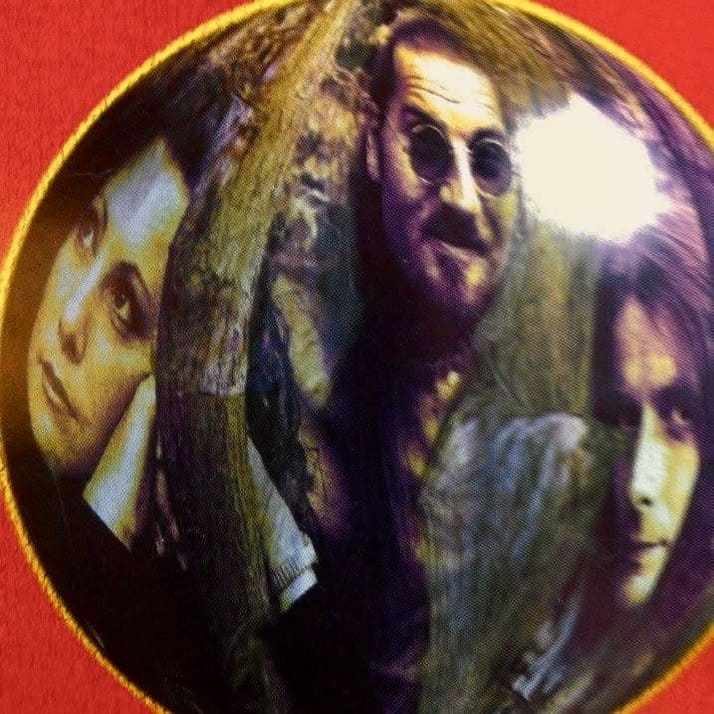
Nella metà degli anni ’90 ti sei preso una pausa dalla musica elettronica e hai pensato di tentare un approccio acustico più “soffice” scegliendo il nome Moonboot Oz. La band era composta da te alla chitarra acustica e alle vocals, da Kim Oz alle vocals e dal batterista Jim Lacey alle percussioni. La formazione ha pubblicato Organic Mushrooms EP e l’album Music Fron the Psychedelic Cafe. Puoi parlarci brevemente dell’album Music From The Psychedelic Cafe e dell’EP Organic Mushrooms?
I Moonboot Oz si formarono poco dopo aver avuto l’idea di un progetto “tutto acustico”, probabilmente l’opposto di quello che avevamo fatto con Astralasia. C’ero io alle vocals e alla chitarra acustica, Kim Oz alle vocals e armonica e il batterista originario di The Magic Mushroom James Lacey alle percussioni. Ecco, questa era tutta la band.
Sia con The Magic Mushroom che con Astralasia eravamo spesso arrivati ad avere un line-up di otto persone tutte le volte. Ora eravamo soltanto noi tre, potevamo fare le prove a casa e viaggiare per i concerti in un’unica macchina con tutto il nostro equipaggiamento dietro. Suonammo a tantissimi festival e in tanti club e divenimmo piuttosto popolari soprattutto come support band per gruppi più grandi perché eravamo velocissimi nel “ripulire” il palcoscenico dopo le performance.
Per quanto riguarda la musica, il mondo era nelle mie mani. L’unica regola era quella di esibirmi con il mio materiale usando soltanto la chitarra acustica. Non c’erano limiti riguardo a quale stile avrei dovuto suonare. Era esilarante essere in possesso di quella libertà e questo faceva scaturire i pezzi dalla mia chitarra in modo estremamente naturale.
L’entusiasmo dei live show
Una volta avevamo messo insieme parecchi show e ci eravamo fatti un nome. Ovvero, le persone sapevano chi eravamo e da dove venivamo. Ci esibimmo con un EP introduttivo intitolato Organic Mushrooms che sembrava mettere bene insieme le influenze della nostra musica. Fu molto ben accolto. Ottenemmo delle belle recensioni e riuscimmo anche ad esibirci in due pezzi in uno show televisivo chiamato Pump T.V. presentato da un giovanissimo Sacha Baron Cohen (Borat). E’ ancora disponibile su tube.
Non troppo tempo dopo, pubblicammo l’album Music From the Psychedelic Cafe, ispirato da uno show che avevamo fatto in una caffetteria a Glastonsbury. Conteneva tutti pezzi inediti, ancora con un vibe acustico ma ci eravamo permessi il lusso di mettere un po’ di basso in alcune parti. Un buon amico, Quiller Rees aveva aggiunto delle parti di keyboards. Ospite speciale fu Janey (Nana Oscuri) che era la cantante nei The Magic Mushoom Band insieme a Kim Oz in quell’epoca. L’intero album fu molto divertente, soprattutto a realizzarlo, e si sente…Di nuovo, non ci sono limitazioni di alcun tipo e il mio songwriting era in un regime di grande libertà. L’ultimo show di Moonboot Oz fu un’apparizione al Festival di Glastonbury nel 1999 e ancora una volta, mollammo tutto mentre eravamo ancora “in alto”…
Garry “Moonboot” Masters: la carriera solista
Un’ultima domanda, ma non meno interessante. Vorrei che mi parlassi di due tuoi eccellenti album solisti. Uno è Electrified Moonboot (mi piace il pezzo Raga Khan, tutto quello che posso commentare su di esso è WOW. E’ molto forte come d’altronde il resto dell’album. Un potente hard rock psichedelico con un sound che sembra venire dritto dagli anni ’60. Non c’è un brano dell’album che non sia bello. Per quanto possa sembrare strano, Bone Idol suona come un innesto tra Cream, Creedence Clearwater Revival e Blue Cheer.
Il meglio poi arriva con l’hard rock con influenze psichedeliche. Qualche volta quando ascolto questo album mi sembra di stare seduto in un bar nel 1967, prendendomi una birra con degli amici ed ascoltando Bone Idol che viene fuori a tutto volume dal jukebox. E’ vero rock, non le sciocchezze formali che senti in radio al giorno d’oggi. Garry potresti per favore raccontarci da dove ti è venuta l’ispirazione e come sono state le registrazioni di questi due album?
Io, Kim Oz e nostra figlia Jasmine siamo emigrati in Australia nel 2002. Abbiamo deciso di prenderci un break dalla musica dopo esserci sistemati in un nuovo paese. Io decisi che era tempo di scrivere un libro, la mia autobiografia Mushrooms & Moonbots.
Il ritorno alla musica
Ci fu un sacco di iniziale interesse a questo riguardo, in più mi dava la possibilità di scrivere tutto prima che la memoria iniziasse ad abbandonarmi. Fortunatamente avevo tenuto da parte ritagli, locandine e poster di quei giorni gloriosi e questo aiutò moltissimo. Ci volle un poco di più di quello che mi ero immaginato e adesso rispetto molto di più tutti gli autori per il lavoro che svolgono. Il libro venne pubblicato nel 2011 disponibile via Amazon e andò eccezionalmente bene. In un attimo ricevetti messaggi da persone che lo avevano acquistato. Alcune dicevano che leggerlo gli aveva fatto rivenire in mente tanti ricordi. Altre all’epoca non c’erano ma leggendo il libro gli parve quasi di essere li.
L’album Bone Idol e l’autobiografia
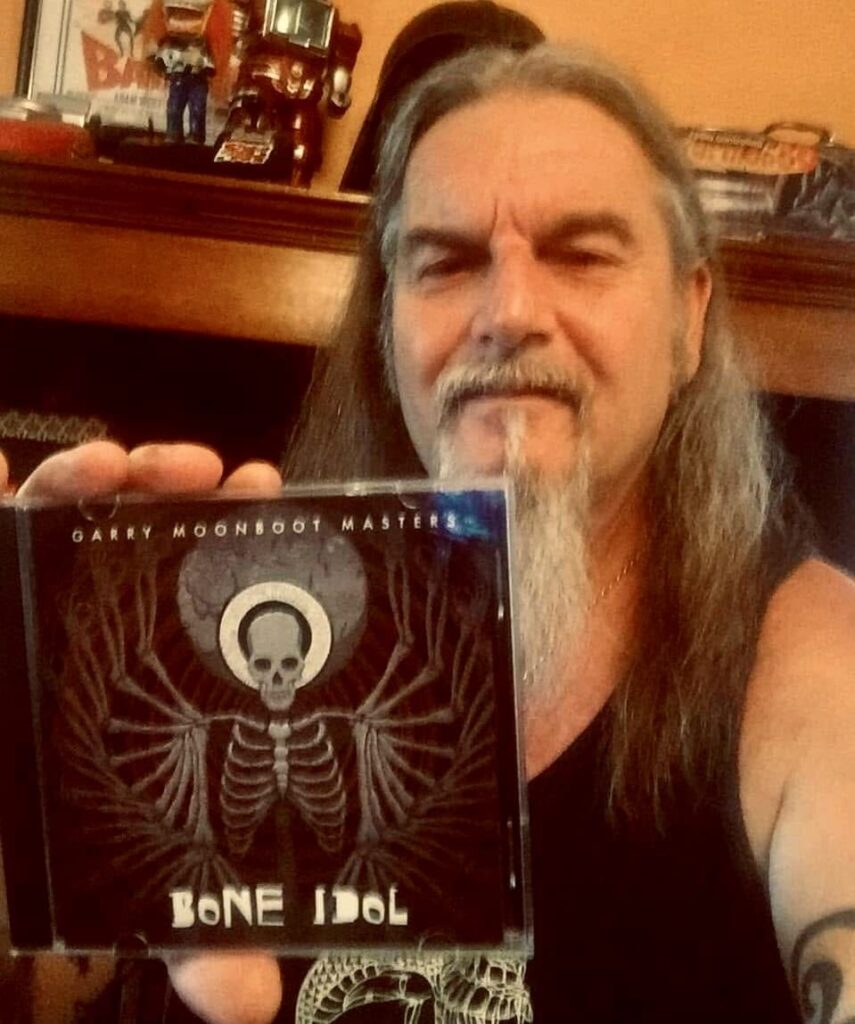
L’ultimo album solista, Bone Idol, l’ho pubblicato qualche anno dopo, con il formato del power trio ma tenendomi libero, per quanto riguardava lo stile, in modo che ogni track potesse essere differente dall’altra. Questa volta decisi di inserire delle voci femminili come backing vocals in alcuni dei pezzi. Mi era sempre piaciuto e certamente la cosa funzionò molto bene nelle mie precedenti band. Così mia figlia Jas e la compagna di Rossco, Renee, entrambe rifinite cantanti, fecero gli “onori di casa”.
Io diedi il mio contributo alla chitarra anche in album di altri musicisti. Si tratta di Mrs Silbury’s Delicious Mushroom Flavoured Biscuit dei Mooch e I-Look di The Higher Craft. Quest’ultimo è un tribute al chitarrista Craig Twining, membro originario di The Magic Mushroom Band venuto a mancare.
Garry, grazie per avermi concesso questa intervista per BACKdigit,com, ti auguro tutto il successo del mondo!
Molte grazie a te per l’interessamento. Con tanto affetto, Garry (Moonboot) Masters.
Garry “Moonboot” Masters: the founder of The Magic Mushroom Band tell us about his London memories of the Sixties and the Seventies
Garry ‘Moonboot’ Masters born and raised in London and currently resides in Australia,
cofounder of ‘The Magic Mushroom Band’, The Magic Mushroom Band side-project electronic music group Astralasia, Moonboot Oz, and his solo releases ‘Electrified Moonboot’ and ‘Bone Idol’, the hard rocking, 1960’s power trio inspired, psychedelic throwback masterpiece. He shares with us some of his many memories, observations, opinions, insights on the 1960’s and 70’s London Music Scene.
Interview to Garry “Moonboot” Masters
How was it growing up in London, the center of the musical universe in the mid to late sixties
and into the 1970’s. Although you were born in 1960, and very young at the time The Beatles,
Stones, Kinks and others ruled the musical world. Could you share any memories you have of
the late 1960’s Hippie Movement, the Beatles breaking up, Jimi Hendrix , Arthur Brown and any
other significant events in the English rock world ?
As you mentioned, I was born in 1960, so not old enough to appreciate the full impact of the psychedelic explosion in swinging London, something I’ve often regretted but as I get older of course, I’m quite happy about that! Luckily I come from a musical family so there was always music around. I grew up in a town called Acton in West London, quite a hotbed of musical activity in itself, ‘The Who’ came from there, in fact my Uncle used to jam with them in an earlier incarnation and my Auntie dated a guy called Terry Nellams who went on to change his name to Adam Faith.
Another great band from Acton were the hard rockers ‘Stray’. I could see the famous ‘Post Office Tower’ in Central London from my bedroom window, that’s how close we were to the action. Later, with a bunch of equally ‘enhanced’ friends we would make our way to the centre of London by foot, if a bus came by we took it but more often than not we’d walk it, more so on the way home in the ungodly hours.
A musical family
As I mentioned, my family were musical and I have very fond memories of family parties where everyone would grab an instrument and those that couldn’t play would sing.. My Dad was an amazing pianist, he loved jazz, boogie-woogie and the blues and he regularly played around the clubs either solo or with a band. My Uncle Eddie is a bassist, been playing since the sixties and still gigs now with blues bands. As for my Grandmother, she was a pianist too and she often played at local pubs, so it truly was in the blood! Sadly they never got to record anything and as was the case then, most of their gigs were playing ‘requests’ of the standards at the time. So I’m very proud to have been the only Masters with a legacy of songwriting, releasing numerous albums and playing my stuff to large audiences…
The first record collections
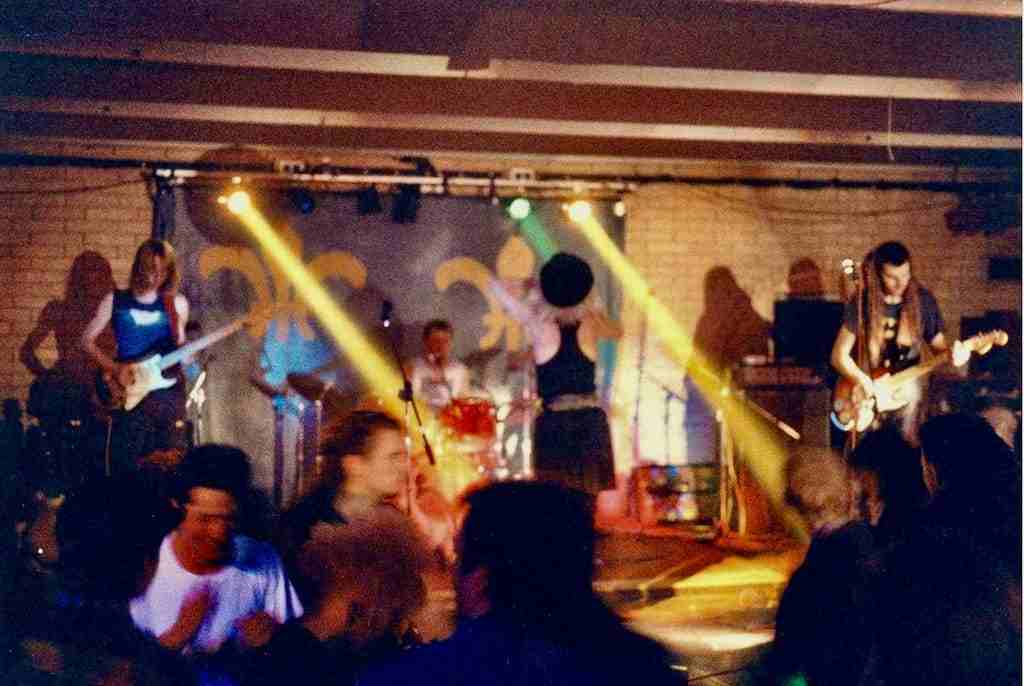
My earliest recollections are obviously the Beatles and Stones, they were everywhere, on the radio, the tv, magazines and of course there was probably one of the earliest forms of band-related paraphernalia, from Beatles boots and wigs to bubble gum cards and posters. As for the psychedelic years, it was more noticable for me as (as a kid) when it became more commercial.
One very vivid memory I have is from a family holiday, we’d often stay at a caravan or camping site near the coast and they always had a clubhouse there. This one particular time, I must’ve been about eight years old, we were making our way to the clubhouse and I could hear this amazing music being played by the D.J and as I entered I was hit by the sheer volume of the music and there was a full-on psychedelic lightshow and the strong smell of incense, with a gaggle of Hippy chicks in brightly coloured clothes wriggling and writhing to the beat and I don’t know what came over me but I knew I just had to join in! My parents thought it was hilarious, but I just felt very comfortable in those surroundings.. a sign of things to come for sure..
From that point on, music meant more to me than just something on the radio.
His first guitar
I was the eldest child in my family but a lot of my friends had older brothers and sisters and we’d often go through their record collections and my younger Uncles and Aunties would share their records with me too.. So, once I’d got through the Batman craze that was prevalent then, the world of music was waiting for me to step on in.. I got my first proper guitar, an acoustic, when I was around twelve years old, before that my Dad had taught me the basics on a ukulele guitar which was much easier on my little hands.
I was hungry to learn, the first 45 I ever bought was ‘Brand New Key’ by Melanie and once I’d worked that out there was no stopping me. I was grateful to my Dad for teaching me the basic rudiments but I was ready to progress and was already writing songs with my limited knowledge.
I got my first electric guitar, a very basic Fender Stratocaster copy, from a newspaper ad and it came with a little practise amp and I’d play that thing from the moment I got home from school until I went to bed, much to the annoyance of my poor suffering sisters in the room next to me.. It was in the early 70’s that my passion for music and guitar playing in particular really took off. By then I’d discovered Hendrix, Cream, Led Zeppelin etc and the acoustic guitar sat in the corner collecting dust for a while.
Garry Moonboot Masters
The rock concerts in London as a teenager
From the age of about thirteen/fourteen I started going to gigs with my friends, we really were spoiled for choice, we could have gone out every night of the week and see an amazing band every time and as we got older we started travelling further afield. Favourite London venues were The Marquee and The Roundhouse, and there were the occasional free events at such places as Hyde Park. As for seeing the larger bands, the next town to Acton was Hammersmith, home of the famous Hammersmith Odeon and we’d go there at least once a month where we’d see many ‘top tier’ bands.
Trendy London shops in the ’60 and ’70
All of this coincided with my introduction to Portobello Road Market in Notting Hill, again just a decent walk from my house. This place had just as much importance to me as the music I was listening to elsewhere. Probably the closest thing we English had to San Francisco’s Haight/Ashbury, the place was a counter-cultural melting pot and I’d managed to discover it while it was still in the (admittedly last) throes of hippiedom.
There I discovered the ‘Head Shops’ and all the associated paraphernalia (underground magazines, comix/pipes/bongs/beads). There were also some great record shops and market stalls which introduced me to the UK ‘underground’ scene where I discovered bands like The Pink Fairies/Deviants, Edgar Broughton Band, Daevid Allen and Gong family.
I’d already discovered Hawkwind when they hit the charts with their single ‘Silver Machine’ seeing that on the t.v was a very pivotal moment for me too. That was the true foundation for my music, as much as the major players had an influence on me, the Underground scene back then was fantastic and showed me that you could take the music anywhere you wanted to and there’d be people out there that would dig it.. So, as the seventies progressed I spent a lot of time not only getting into what was happening at the time but also trying to catch up with what I’d missed at the height of the ‘sixties..
Garry Moonboot Masters
The Magic Mushroom Band and the Hawkwind
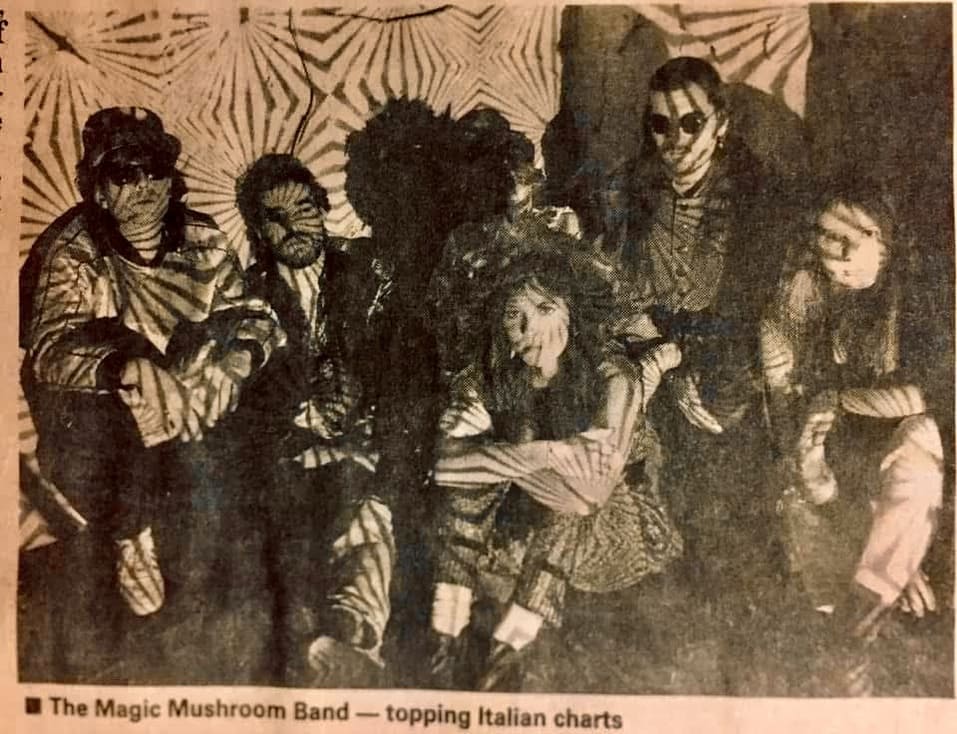
When The Magic Mushroom Band appeared at the Stonehenge Festival in 1983 or 1984, did Hawkwind appear on either bill ? If not, did The Magic Mushroom Band ever appear on the same bill as Hawkwind? What’s your opinion on Hawkwind? Were they an influence on you and the Magic Mushroom Band?
The Magic Mushroom Band played at both the 1983 and 1984 Stonehenge festivals and Hawkwind played at both too from what I can recall.. We never got to play the ‘Main Stage’ as we were too busy playing on other stages around the site, playing wherever and whenever we could, although I heard later that we were called up to play on the main stage at one point but we were playing somewhere else there at the time..
Yes we played with Hawkwind many times over the years, either at ‘all-dayers’ with a host of other bands or just as support act for them.
As I mentioned earlier, they were a huge influence on me and other members of the band and I’d followed them since they had their chart hit with ‘Silver Machine’ so it was a great honour to share the stage with them eventually.
Garry Moonboot Masters
The glam rock of David Bowie and Marc Bolan’s T.Rex
Garry, what’s your opinion on Glam Rock? Then to expand on that question, what is your opinion of David Bowie’s, Ziggy Stardust character ? What was your reaction to the album ? Did Ziggy have any influence on British fashion, hairstyles etc ? At one time the glam rock world was ruled by Bowie and Marc Bolan, with both fans proclaiming one or the other was better. Which of the two did you prefer ?
For myself as a young teenager, Glam Rock was great! I loved T.Rex, great no-nonsense boogie, I loved Marc’s lyrics and the simple tunes he layed out was just perfect. I also enjoyed learning that stuff on guitar too.. Knowing my love for T.Rex, my Uncle gave me two of the early Tyrannosaurus Rex albums and they appealed to the burgeoning hippy in me too..Apart from T.Rex, we had Bowie, Alice Cooper, Mott the Hoople and many more, so much great music and the quality of stuff that was in the charts at the time is hard to believe now..
When Bowie introduced his Ziggy Stardust character , it was really like he’d become like a shape-shifting androgynous alien not ‘camp’ like the other Glam Rockers, as was the trend at the time, but like a being from another planet. Mick Ronson played a huge part in developing the Spiders from Mars sound but it was Bowie’s songs and lyrics that were like no other.. I’d be hard pushed to say whether I preferred Bolan or Bowie as although they were in the same scene, they were individually unique but I would say that Bowie took his music forward as he progressed, constantly re-inventing himself and although Bolan tragically died in 1977 his music by then had kinda lost its sparkle as it were..
Garry talks about Alice Coopers’ beginning
There’s one more name I’d like to mention, Alice Cooper ? Was he popular in England? I really liked his earlier material like ‘Ballad of Dwight Fry’, was he artistic performance techniques, which included the use of the gallows, guillotine , and straight jacket , and don’t forget his pet boa constrictor.
Yes, Alice Cooper was huge once ‘School’s Out’ was released as a single, very clever move, with a theme like that it was guaranteed to get the kids buying it in droves. Although he was under the ‘Glam-Rock’ umbrella, he introduced ‘Shock-Rock’ to the world, something only previously done before by acts like Screaming Lord Sutch and of course, Arthur Brown.. The singles he released after were all great too, as were his early albums.. pretty much up until he kinda went ‘off the rails’ in the late 70’s and then became a bit more standardised Heavy Metal in the ‘eighties.. although I did see him live around that time and he did a lot of his old hits and theatrics and even the newer stuff was better live.
Here’s the story of The Magic Mushroom Band
The Magic Mushroom Band played at both the 1983 and 1984 Stonehenge festivals and Hawkwind played at both too from what I can recall.. We never got to play the ‘Main Stage’ as we were too busy playing on other stages around the site, playing wherever and whenever we could, although I heard later that we were called up to play on the main stage at one point but we were playing somewhere else there at the time..
Yes we played with Hawkwind many times over the years, either at ‘all-dayers’ with a host of other bands or just as support act for them.
As I mentioned earlier, they were a huge influence on me and other members of the band and I’d followed them since they had their chart hit with ‘Silver Machine’ so it was a great honour to share the stage with them eventually. With The Magic Mushroom Band we were all about a ‘good time’ something we inherited from previous bands in the same vein..
In 1982 when the band formed, ‘New Wave’ and ‘New Romantics’ had risen from the chaos that was punk and their general outlook was often quite dark and gloomy. A lot of my songs were upbeat with a positive message which came across well in the recordings and even more so at the live concerts, especially when combined with the psychedelic light shows that we used from day one.. If you came to one of our shows back then you were pretty much guaranteed a good time and in fact people even now contact me and say that they have very fond memories of our live shows and the joy that they brought, friendships were forged there and some romantic relationships too!
Music and psichedelic lightning
So, people came to dance and share the love, illuminated by psychedelic lighting.. We had a good D.J friend called Kevin who back in 1988 told us of a new scene breaking called ‘Acid House’ where the kids were getting together to dance, share the love, illuminated by psychedelic lighting! Of course the music was very different, the 4/4 rock feel had been substituted by dance beats.
A new line-up for the band
Garry, I want to touch on the Magic Mushroom Band, the band you were a cofounder of in 1982, and the Magic Mushroom Band side-project Astralasia. Could you please give myself and the readers a brief overview of the tangled web of dynamics of these two interrelated bands.
In 1990 The Magic Mushroom debuted a re-vamped lineup, original guitarist Craig Twining had left to pursue new ventures as had original drummer James Lacey, to be replaced by Ed ‘Bones’ Genis on slide/rhythm guitar, Sam Turner on electric violin, Kim Oz took on keyboard duties as well as singing and our new drummer was Swordfish, who had been producer/engineer on our second and third albums ‘Bomshamkar’ and ‘Eyes of the Angel’. We promptly got stuck into our next album which was ‘Process of Illumination’.
By that time the Acid House scene had grown and new genres were forming from it such as World/Ambient/Techno/Trance and Swordfish was happily experimenting with that kind of stuff inbetween working on our new album. We did a cassette e.p of experimental sounds in that vein to test the water and used the name ‘Astralasia’ to differentiate it from The Magic Mushroom Band although the early stuff featured all the same members and it was well known in the scene that we were one and the same. This helped to boost Astralasia and in turn a lot of the ravers were turned on to The Magic Mushroom Band. As time went on we’d often do live shows with both bands taking turns at either main act or support.
Garry Moonboot Masters
The success of The Magic Mushroom Band and Astralasia
In 1992 both acts were signed up by Magick Eye Records and a slew of 12”s and albums were released from each band, the best record company we ever had with decent distribution and strong advertising which helped to boost both bands. The first album for Magick Eye Records by The Magic Mushroom Band was called ‘Re-Hash’ a play on words as we’d decided to re-record a lot of the most popular Magic Mushroom Band songs, but with the new dance beats added and that in turn helped to bridge the gap between our psychedelic rock and the dance scene. Both bands continued to release albums and 12″‘s, but by 1994 the scene had changed for The Magic Mushroom Band, the dance scene had begun to overshadow what we were doing and promoters were tending to book acts more in that vein.
Garry Moonboot Masters
Astralasia’s success
As Astralasia’s popularity grew it became increasingly difficult to balance the two and it was at that point that it was thought best to lay The Magic Mushroom Band to rest.. leave it on a ‘high’ as it were..
In the meantime, Astralasia was pumping out lots of new music and the shows were getting bigger and more elaborate but as time went on I found myself a bit of a ‘spare wheel’ as a guitarist, the guitar was not a prominent instrument in that scene and I began to feel unfulfilled and a little stifled by the rigidity of the digital demands., so in 1985 myself and Kim Oz decided to leave Astralasia. They are still a going concern now, there’s been a few line up changes over the years but always with Swordfish at the helm..
Garry Moonboot Masters
Garry and his Moonboot Oz
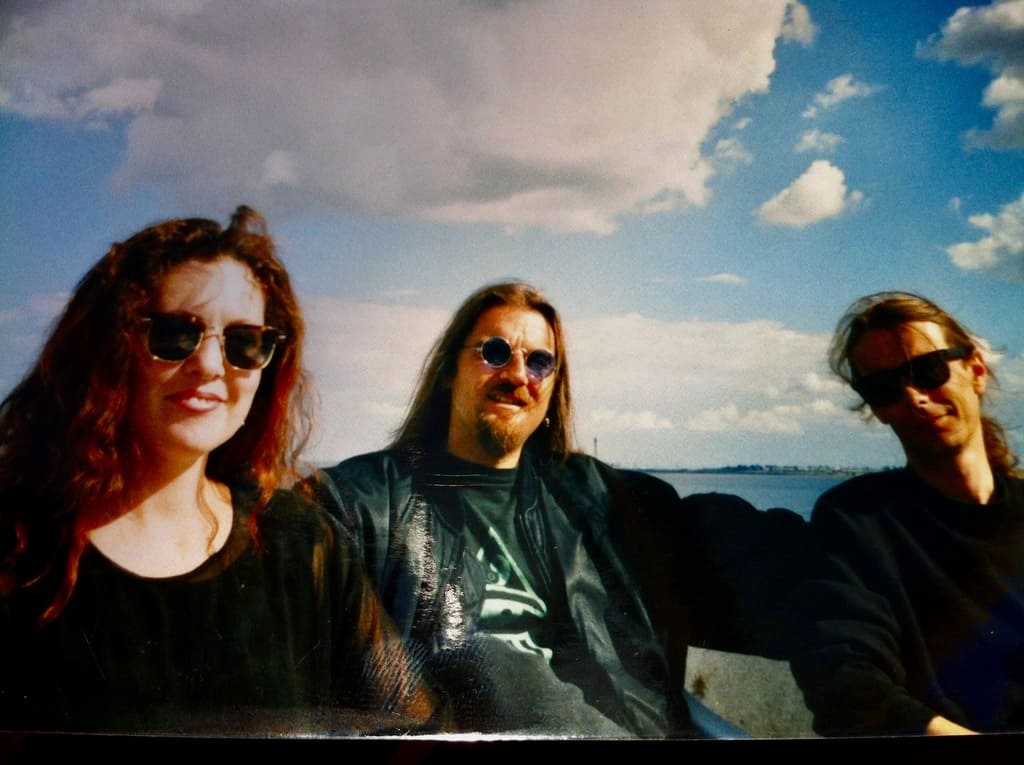
In the mid-1990’s You took a break from electronic music and decided to try a softer acoustic approach going by the name ‘Moonboot Oz’. The band was composed of yourself on acoustic guitar and vocals , Kim Oz on vocals, and drummer Jim Lacey on percussion. Which released, ‘Organic Mushrooms’EP and the album ‘Music From The Psychedelic Cafe’. Could you give us a brief rundown on the album ‘Music From The Psychedelic Cafe’ and also the ‘Organic Mushrooms’ EP.
Moonboot Oz was formed not long after, the idea of an ‘all-acoustic’ project was exciting, probably the polar opposite of what we’d been doing in Astralasia. It was myself on vocals and acoustic guitar, Kim Oz on vocals and harmonium and our original Magic mushroom Band drummer James Lacey on percussion and that was it, the whole band..
With both Magic Mushroom Band and Astralasia we’d often have up to eight people in the band at any given time. Now it was just the three of us, we could rehearse at home and travel to gigs in just the one car with all our equipment in the boot. We got to play lots of festivals and clubs and we became quite popular to have as a support act for larger bands as we were quick to clear the stage!
As for the music, the world was my oyster, the only rule was that I had to be able to perform my stuff on just an acoustic guitar, there no limits on what style I had to adhere to and the freedom of that was exhilarating and the songs just started pouring out of me.
Garry Moonboot Masters
The enthusiasm of the live shows
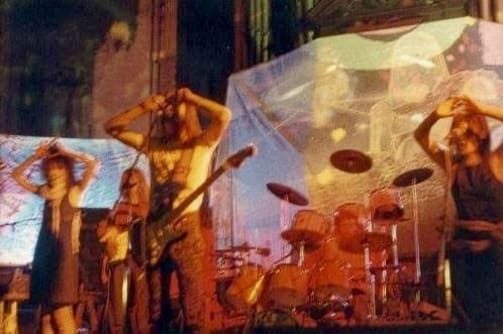
Once we had a few shows under our belt and had began to make a name for ourselves (and people had realised who we were and the bands we’d come from) we did an introductory e.p called ‘Organic Mushrooms’ which seemed to sum it up nicely. It was well received and got some good reviews and we even got to perform two of the tracks on a t.v show called ‘Pump T.V’ hosted by a very young Sacha Baron Cohen (Borat) it’s available to watch on youtube.
Not long after, we released the album ‘Music from the Psychedelic Cafe’, inspired by a show we’d done at a cafe in Glastonbury. It featured all-new songs, still with the acoustic vibe but we allowed ourselves the luxury of a bit of bass guitar on some tracks, a good friend Quiller Rees added some keyboard textures in places and a special guest was Janey (Nana Obscuri) who was singer in The Magic Mushroom Band alongside Kim Oz back in the early days. The whole album was a lot of fun to make and it shows.. again there were no genre limitations and my songwriting was given total free reign.. The last show Moonboot Oz did was an appearance at the 1999 Glastonbury Festival where, again, we left it on a ‘high’..
Garry Moonboot Masters
Garry “Moonboot” Masters and the solo career
Last but not least, I’d like for you to delve into your two excellent solo albums, Electrified Moonboot (I love the song Raga Khan all I can say about that song is ‘WOW’) . It’s just awesome as is the rest of the album. ‘Bone Idol’, a just totally awesome album. With a hard rocking psychedelic power trio, 1960’s throwback sound. There’s not a bad song on the album.
As strange as this might sound, Bone Idol sounds like a cross between Cream, Creedence Clearwater Revival and Blue Cheer. The cream of the crop when it comes to hard rocking psychedelic rock. Sometimes when I listen this album. I feel like I’m sitting in a bar
back in 1967, having a beer with some friends listening to ‘Bone Idol’ blasting out of the jukebox. It’s real rock not the formalistic drivel you hear on the radio today. Gary could
you please give us an overview of the inspiration, and recording of these two albums.
Myself, Kim Oz and our daughter Jasmine emigrated to Australia in 2002. I’d decided to take a break from playing music and after settling into my new country I decided it was time to write a book, my auto-biography ‘Mushrooms & Moonbots’.
Garry Moonboot Masters
The Garry “Moonboot” Masters’ autobiography
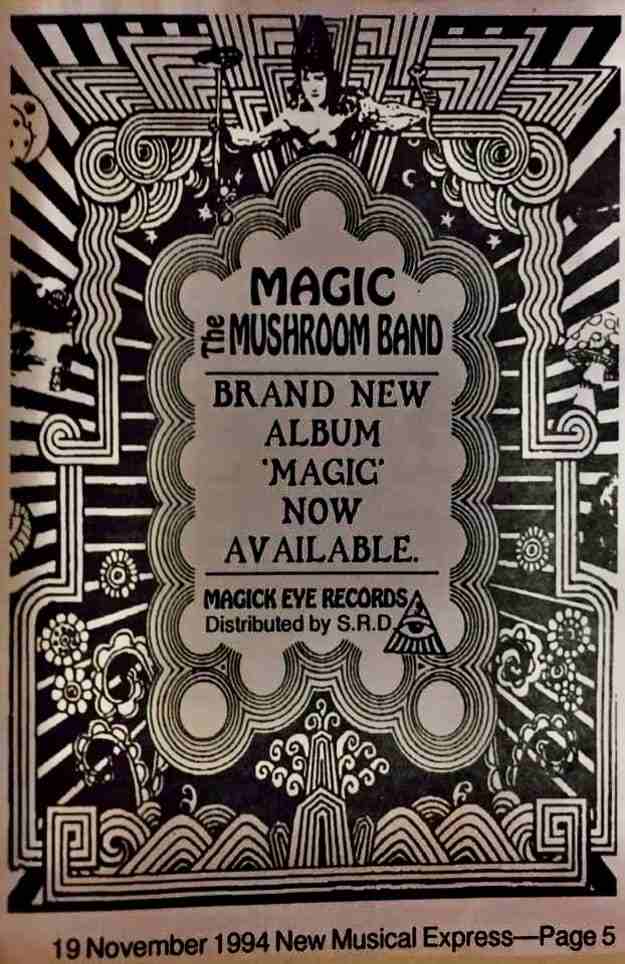
There was a lot of initial interest in me doing it plus it gave me a good opportunity to get it all written down before my memory started to fade, luckily I’d kept scrapbooks, flyers and posters from those glory days and that helped a lot. It took a lot longer than I expected and I hold all authors in much higher esteem now! It got published in 2011 and was available worldwide via Amazon and it did exceedingly well, in no time I was getting messages from people who’d bought it who either said it brought back such memories for them and even the ones who bought it who weren’t there said the book made them feel like they were.
Garry Moonboot Masters
The comeback to music
Fast forward to 2013, Kim Oz and I had gone separate ways and I was looking to get back into my music. Of course in my quest to keep everything fresh and not rely too much on what I’d done before, I decided it was time to do a solo album. I had an excellent recording studio and engineer at hand (my son-in-law Michael, also an amazing guitarist) and a fantastic drummer, the mighty Rossco.
After a few jams it felt right to try something I hadn’t done before and always admired and that was the classic ‘Power Trio’ format, if it was good enough for Hendrix and Cream then it was good enough for me, so with that in mind I set to writing stuff in that vein. Again, once I had a ‘theme’ the songs poured out of me and before I knew it I had an album’s worth of material. I’d decided to play bass on the album too, because I could and it was fun to do.
We recorded ‘Elecktrified Moonboot’ over a couple of months with the luxury of not having to watch the clock. It turned out really well and again, like my book, I released it via Amazon which guaranteed it worldwide distribution. It got great reviews in quite a few magazines and it even reached the number one spot at my local radio station here, even though they had no knowledge of my background.
Bone Idol solo album
The latest solo album ‘Bone Idol’ was released a few years later, again with the power trio format but keeping the style open enough to make each track different from the other. this time I decided I’d like some girlie backing vocals on some of the tracks, I’ve always liked that and it certainly worked well in the previous bands, so my daughter Jas and Rossco’s lady Renee, both fine singers, did the honours..
I’ve also contributed guitar tracks to a couple of other people’s albums, namely ‘Mrs Silbury’s Delicious Mushroom Flavoured Biscuit’ by MOOCH and ‘I-Look’ by The Higher Craft, a tribute album to recently-deceased former Magic Mushroom Band guitarist Craig Twining.
Garry I wanted to thank you for consenting to be interviewed for Backdigit.com and I wish
you all the success in the world,
Many thanks for your interest
Big Luv
Garry (Moonboot) Masters
LEGGI ANCHE:
- Becoming Led Zeppelin: arriva il primo docufilm sulla leggendaria rock band
- “Their Satanic Majesties Request”: il contributo dei Rolling Stones alla psichedelia
- The Cult: la rock band inglese “di culto” celebra i 40 anni
- “The Velvet Underground and Nico”. Le difficoltà e le tribolazioni del capolavoro dell’Art Rock
- Moody Blues: alla riscoperta di In Search of a Lost Chord, terzo mitico album della celebre rock band
- UFO Club: il locale che ha lanciato i Pink Floyd e ha fatto la storia della psichedelia inglese
- One to One: John & Yoko – Un docufilm evento tra musica, amore e rivoluzione firmato Kevin Macdonald
- I Pink Floyd tornano al cinema: trionfo per Pink Floyd at Pompeii – MCMLXXII, il film concerto restaurato in 4K e Dolby Atmos
- BRUCE SPRINGSTEEN: ARRIVA “TRACKS II: THE LOST ALBUMS” CON SETTE ALBUM INEDITI
- YUNO: il nuovo album “Blest” scuote la scena
Offerte Di Amazon Prime
Iscriviti ad Amazon Prime per guardare film e programmi TV popolari, inclusi i pluripremiati Amazon Original. Amazon Prime offre anche la consegna GRATUITA in un giorno sugli articoli Prime idonei e molto altro.

Amazon.it - ULTIMEA Soundbar TV, con Dolby Atmos/Digital/Audio, Sound Bar con Subwoofer, Bassi Profondi Regolabili, Soundbar 3D Dolby Surround TV, Soundbar per TV Home Theater, HDMI-eARC, Bluetooth 5.3, Nova S50
Miglior Prezzo 14900€
Spedizione in 1 giorno senza costi aggiuntivi
E molti altri vantaggi con Prime
Combatti La Muffa

Amazon.it - COMFEE' Deumidificatore Casa Muffa 12L/24h, Adatto fino a 20㎡, Filtro Lavabile, Ruote Piroettanti, R290, MDDN-12DEN7
Miglior Prezzo 11999€
4 mesi d'uso GRATUITO
Offerta a tempo limitato.
3 mesi gratuiti per i clienti senza abbonamento Prime.

Amazon.it - CAMP Rimuovi Muffa - Antimuffa per Muri Interni ed Esterni ad Azione Rapida, Spray Antimuffa Igienizzante Pronto all'Uso, Ideale per Rimuovere Muffe, Muschi e Funghi - Prodotti Pulizia Casa, 750 ml''
Miglior Prezzo 1590€
Il Meglio Dell'Intrattenimento

Amazon.it - Hisense TV 55" Mini-LED 144Hz 4K 2025 55U72Q, Smart TV VIDAA U8, Dolby Vision IQ, HDR 10+ Adaptive, 144Hz Game Mode PRO, Dolby Atmos 2.1 con Subwoofer, Alexa Built-in, VIDAA Voice, lativù 4K, 55''
Miglior Prezzo 54900€
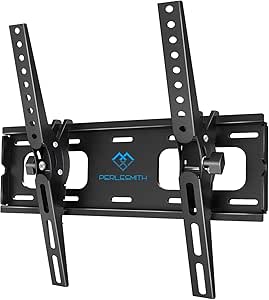
Amazon.it - PERLESMITH Supporto TV Parete con Inclinazione Senza Attrezzi, Staffa TV Inclinabile da 26-65 Pollici Fino a 60 kg, Max VESA 400x400 mm
Miglior Prezzo 2589€

Amazon.it - Fire TV Stick 4K di Amazon (Ultimo modello), Dispositivo per lo streaming con supporto per Wi-Fi 6, Dolby Vision/Atmos e HDR10+
Miglior Prezzo 6999€





